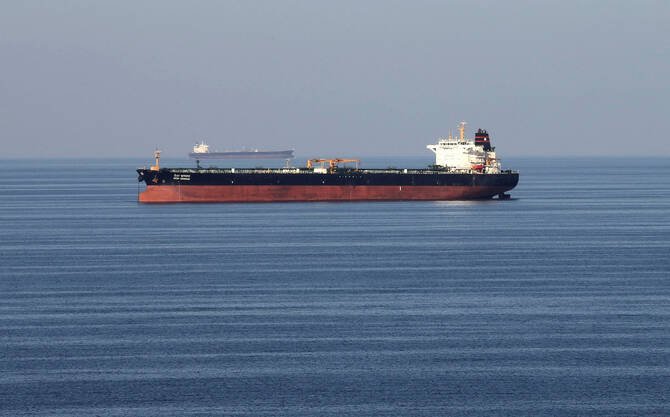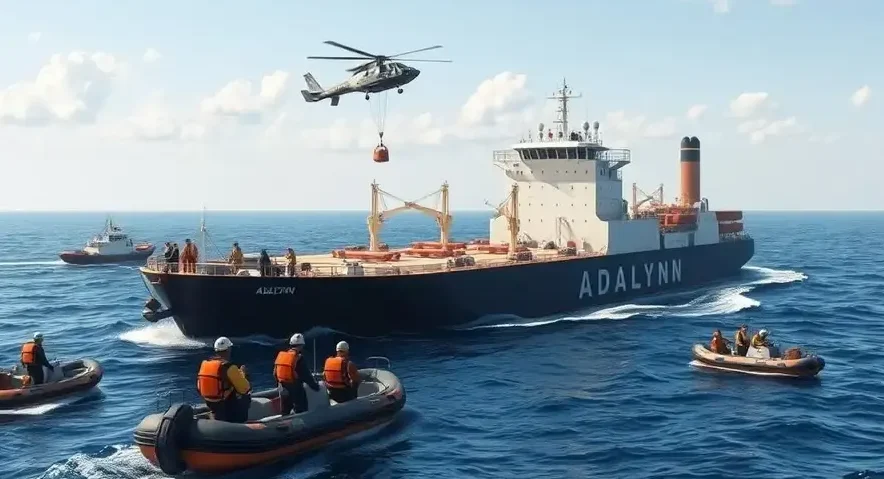In a powerful and well-coordinated maritime rescue, the UAE Coast Guard safely evacuated 24 crew members after an oil tanker collided with another vessel near the highly strategic Strait of Hormuz. The operation, executed swiftly, averted disaster and showcased the UAE’s growing role as a leader in regional maritime safety and emergency response.
The rescued crew members were transported to Khor Fakkan port in the UAE after the incident took place in the Gulf of Oman, approximately 24 nautical miles east of the coast. The situation was brought under control rapidly, and no casualties or severe injuries were reported.
The Incident Unfolds
The oil tanker, reportedly en route toward Egypt, was involved in a collision early Tuesday morning. Conditions at sea were stable, and there were no prior warnings of distress. The nature of the collision remains under investigation, but authorities confirmed there were no indications of sabotage or hostile action. This appears to be a straightforward maritime accident.

Emergency alerts triggered a rapid deployment of UAE coast guard vessels and support teams. Within an hour, rescue boats arrived and executed a full evacuation. Despite the scale of the accident, no fire broke out on the tanker itself, and there was no significant spillage of oil.
Why the Strait of Hormuz Matters
The Strait of Hormuz is a narrow maritime corridor between the Persian Gulf and the Gulf of Oman. It is one of the most critical waterways in global oil transport, with a substantial share of the world’s petroleum passing through it each day.
This region has historically been prone to geopolitical tensions, but maritime operations have largely remained uninterrupted. That said, any incident in these waters immediately raises concerns about global energy flows, potential supply chain disruptions, and shipping lane safety.
In such a high-stakes environment, a rapid and effective response—like the one demonstrated by the UAE—goes a long way in restoring calm and ensuring continuity of operations.
UAE’s Fast, Flawless Emergency Response
The UAE’s handling of the situation was swift, organised, and highly effective. The emergency response showcased a blend of strategic planning, technological deployment, and human coordination. Search-and-rescue boats reached the collision site promptly and facilitated the complete evacuation of the tanker crew.
From logistics to medical screening, every step was carefully managed. The crew received immediate care upon arrival at port, including hydration, rest, and basic medical checkups. Many were fatigued but unharmed. There were no serious medical emergencies reported, a testament to how quickly the situation was brought under control.
Oil Market Sensitivity and Economic Ripples
Even when no fuel leakage or fire occurs, an incident involving an oil tanker in this region sends ripples across global oil markets. Traders and insurers remain highly sensitive to maritime safety developments in the Gulf, often reacting to incidents with pricing changes and risk evaluations.
In the days following the collision, freight rates surged across some regional shipping lanes. Some ship operators have grown cautious, even choosing to reroute vessels or delay departures until further safety assessments are completed.
This pattern underscores the interconnectivity of maritime safety and global economic stability. Even minor incidents can trigger broad-scale reactions when they occur near key energy transit corridors.

Geopolitical Tensions and Maritime Caution
While the tanker collision was ruled an accident, it occurred during a period of heightened regional tensions. The broader Middle East has been on alert due to geopolitical events, with increasing naval activity from multiple countries and heightened electronic surveillance in international waters.
Some commercial ships in the area have reported unusual disruptions to navigation signals in recent weeks. While there is no confirmed link between these anomalies and the recent tanker incident, maritime operators remain wary of electronic interference, miscommunication, and other non-traditional risk factors.
Against this backdrop, the UAE’s smooth and professional response not only ensured safety but also helped to temper speculation and reassure the global shipping community.
The Human Element: Focus on Crew Safety
For the 24 crew members aboard the tanker, the experience could have been traumatic—but thanks to quick action, their ordeal ended with relief and gratitude. Although their identities and nationalities have not been disclosed, officials confirmed that they received food, rest, medical checks, and support upon arrival.
Human safety remains the core mission in any emergency response. In this case, every effort was made to ensure not just survival, but the well-being and dignity of each crew member. Some of the crew may have been transferred to temporary housing pending further assistance, but morale among them reportedly remained positive.
Environmental Impact and Future Monitoring
Fortunately, this collision did not escalate into an environmental crisis. There were no reports of significant oil leakage or water contamination. However, precautionary measures have been taken, and ongoing monitoring efforts are being conducted near the site of the incident.
Environmental risk in such accidents cannot be understated. The UAE continues to invest in technologies and response protocols designed to prevent and, if necessary, contain oil spills. Environmental agencies are likely to inspect the affected vessels and surrounding water zones to ensure long-term marine safety.
A Reminder for the Maritime Industry
This incident serves as a timely reminder of the risks that still exist despite advanced navigation technologies and international regulations. As maritime traffic grows and sea routes become more congested, even a momentary lapse can result in significant events.
Industry leaders and maritime authorities may take this moment to review safety protocols, enhance training for crews, and consider updated regulations for high-traffic zones. Emergency drills, upgraded vessel tracking systems, and coordinated response frameworks will all play a role in reducing future incidents.
Reaffirming UAE’s Maritime Leadership
With each successful emergency operation, the UAE continues to cement its status as a leader in regional maritime safety. The country has invested heavily in coast guard infrastructure, naval coordination, and port-side emergency services.
These efforts are now paying dividends—not only for the safety of its own waters but for the confidence it brings to international shipping firms that rely on these transit routes daily.
The rescue effort highlighted a capable, disciplined maritime response force working in synchrony with port authorities and medical teams. It also displayed a strong humanitarian instinct—ensuring that crew members are not just rescued, but cared for and supported.
What Comes Next

A formal investigation into the cause of the collision is already underway. Maritime authorities will examine navigation logs, crew statements, technical equipment, and weather data to determine the sequence of events. While no foul play is suspected, understanding the exact cause remains important for legal, insurance, and safety purposes.
Meanwhile, both vessels involved will undergo inspections and likely remain docked until cleared. Shipowners may also conduct their own internal reviews to prevent a recurrence.
This situation may lead to renewed calls for a regional maritime safety forum—where Gulf states and commercial operators can coordinate more effectively on navigational standards and emergency collaboration.
Final Thoughts
In a region where shipping is the lifeblood of economies and a key pillar of global trade, every successful rescue tells a bigger story. The UAE’s rescue of 24 crew members from a damaged oil tanker is more than a maritime operation—it’s a display of capability, compassion, and composure under pressure.
It also reaffirms a vital truth: that amidst rising tensions and uncertain waters, leadership, preparation, and humanity remain the strongest forces at sea.
Do follow UAE Stories on Instagram













